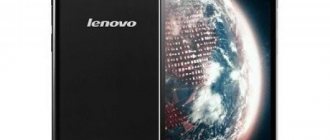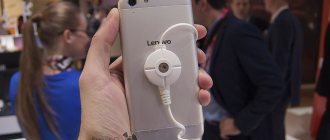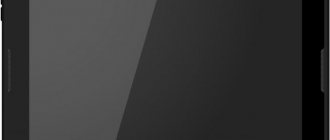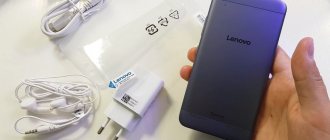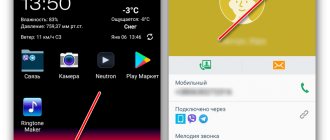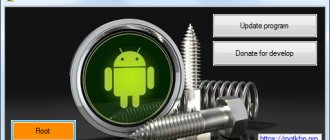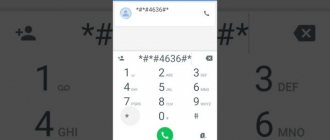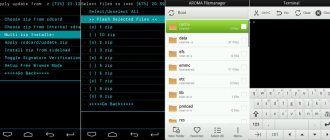Lenovo is a reliable manufacturer of PCs and laptops, and now the company has also ventured into smartphones. She paid special attention to this area in 2014 and began to intensify production. One of the new products capable of operating in 4G networks is the Lenovo A606. The phone comes with a quad 1.3GHz Cortex A7 MediaTek MT6582M processor and 1GB of RAM. There is an 8MP camera on the back and a 2MP camera on the front. The 8GB of internal storage can be expanded up to 32GB via micro SD cards. Additionally, there are a few things about the phone's design and interface that give the device a slight edge over competitors in the same price range (under $100).
Design
The Lenovo A606 smartphone is simple and elegant; there is nothing superfluous on the back or front. Dimensions - 141.5x73.2x9.1 mm - are standard. The width of the screen bezel is consistent with other mid-range phones, although, for example, the Note 4 or Ascend Mat 7 have already gotten rid of it.
Unlike most smartphones, Lenovo decided to place the charging and headphone jacks on the top panel. Below them on the front side is the speaker grille. At the bottom there are 3 capacitive buttons that are not backlit, which negatively affects the functionality of the phone. There's nothing on the left. The frame along the edge is finished with a beautiful metal strip. Another advantage of the design is the less rounded corners, which enhance the elegance of the phone. Otherwise, the A606 would resemble the Galaxy Core shape, which, according to some users, greatly spoils the appearance of the smartphone. The back panel is also sleek and very simple. Lenovo has used high-quality plastic that provides good grip on the hand. At the top there is a camera with a flash, and directly below them is the manufacturer’s logo, the size of which is much larger than on the front side.
The weight of the device is 170g. The phone is a little heavy, but considering that it is a 5-inch model with 4G support, this is acceptable. It's easy to carry and fits easily into your jeans pocket. The case for Lenovo A606 is not included.
Lenovo A606 Smartphone: Review
Dimensions and weight - 3.9
The Lenovo A606 phone is a large, wide and heavy 5-inch all-in-one made of plastic. The design can be called classic for a Lenovo smartphone, in our opinion, nothing remarkable or eye-catching: a monotonous rectangle with rounded edges and a Lenovo logo with a thin border along the edges of the front panel. Below the display are three non-backlit buttons. The control buttons are in their usual place - on the upper part of the right side. The back panel is removable and made of soft-touch material reminiscent of rubber: when we removed the cover, we saw how easily it bends and bends at the edges. In fact, the plastic cover is “dressed” in a cover like a rubber one. This is the first time we have seen this during testing.
Using the Lenovo A606 with one hand is inconvenient; after all, it is 5 inches. The device dimensions are 141.5x75.6x10.6 mm, weight is 172 grams. Even the Lenovo P780, with its huge battery, was a little thinner and weighed almost the same. The display quickly collects fingerprints, but you can easily wipe them off, but the back with a slightly protruding lens remains clean all the time. If we talk about the build quality, it is at a good level - nothing loose or bends. By the way, in the case the phone almost does not slip out of your hands and is easily fixed; without it, the phone may accidentally fall out due to the slippery back. Let's also say that at first the smartphone may seem inseparable, but in fact you can easily remove the cover, under which there is a removable battery. Lenovo A606 can be purchased in black and white colors.
Screen - 3.4
The Lenovo A606 display diagonal is 5 inches. This diagonal will be enough for comfortable reading and watching videos, but using the phone with one hand is a bit difficult. Matrix type - IPS, screen resolution - 854x480 pixels (PPI - 196 pixels per inch; for five inches, this resolution looks, in our opinion, very poor - the image comes out fuzzy and blurry). The smartphone does not have an oleophobic coating or protective glass, so the display “collects” fingerprints, but they can be wiped off. The device also has an automatic brightness adjustment function, we checked its operation - generally not bad, but not as fast as we would like. But the touchscreen works quickly, but only recognizes up to two touches.
The screen has an average brightness level - up to 348 cd/m2, average viewing angles and low contrast. The minimum adjustable brightness is 13 cd/m2, which will be convenient for reading at night. On a sunny day, the information on the screen remains readable. There is no operating mode for gloves. In our opinion, the display is not the Lenovo A606's strong point: it has a fuzzy image and low contrast.
Camera
The Lenovo A606 smartphone uses an 8 MP camera with LED flash, face recognition and autofocus. The flash, by the way, can serve as a flashlight. The maximum photo resolution is 3264 by 2448 pixels. The camera's capabilities are not that great, but they are quite consistent with the price of the smartphone and the declared pixels. There is also a front camera, with a good resolution of 2 MP, which is not too little for an additional camera. The main camera shoots video in a resolution of 1920x1080 pixels, albeit with a frame rate of only 15 frames per second, but the sound is recorded in stereo mode and there is a tracking autofocus function. The cameras are far from flagship ones, but they can easily replace a point-and-shoot camera and the quality corresponds to the stated megapixels.
Photo from Lenovo A606 camera - 3.5
View original photos
Working with text - 1.0
The Lenovo A606 uses a standard Google keyboard. The function of continuous text input, a separate button for switching languages, there is no marking of additional characters, only the top row of keys allows you to enter numbers by pressing a key. At the same time, the keyboard has a dot and a comma at once; in some cases, keyboards in the Russian layout do not have a comma on the screen.
Internet - 3.0
Google Chrome with support for synchronizing tabs with the desktop version of the browser and Yandex Browser with an address bar at the bottom of the display are preinstalled as browsers on the Lenovo A606. There is no support for multiple page scaling or a separate reading mode. But you can manually set the font size for one-time scaling. After double-clicking on the page, all text will be scaled to the size you select, which is very convenient, according to user reviews. Yandex.Browser has a “Turbo” mode for faster page loading, the ability to close tabs automatically when exiting the browser, etc.
Interfaces
Lenovo A606 supports the most common wireless interfaces: Wi-Fi (b/g/n) with the ability to distribute the Internet to other devices, Bluetooth v4.0 with support for the A2DP profile for music transfer and A-GPS. All of them functioned normally during our tests. The smartphone has one slot for a mini-SIM card, and there is also a micro-USB 2.0 connector on the top end of the phone. However, the main feature of the smartphone is LTE support.
Multimedia - 4.2
The Lenovo A606 video player supports many common formats and codecs and plays videos in high quality, up to 1080p. There is no choice of subtitles and audio tracks in the built-in video player. The audio player plays popular formats such as MP3 and AAC, as well as “high quality” formats – FLAC and WAV.
Battery - 3.0
The device is equipped with a removable battery with a capacity of 2000 mAh. The Lenovo A606 showed excellent results for a budget phone in battery life tests. The smartphone played HD video at maximum brightness for 6 hours. In our test, listening to music with the screen off, the device discharged in 67 hours. The Lenovo A606 charges relatively quickly - it took us about two hours to fully charge the smartphone.
Performance - 2.0
| Chipset: | Mediatek MT6582 |
| Number of cores and frequency: | four cores, 1.3 GHz |
| RAM: | 1 GB |
| Built-in memory capacity: | 8 GB |
| GPU: | Mali-400MP2 |
The Lenovo A606 uses a budget but quite powerful MediaTek MT6582 platform with 4 processor cores and a frequency of 1.3 GHz, and a Mali-400 MP graphics subsystem. The amount of RAM is 1 GB. The performance of the smartphone according to the test results is normal, it is enough for most tasks, including many games. Note that when browsing the web it froze a little, and in games, for example, Asphalt 8, it slowed down at medium settings, but at low settings everything went quite smoothly. As for benchmarks, the Lenovo A606 received average scores - 19314 points in AnTuTu, but rather modest achievements in graphics - 2861 points in the Ice Storm Unlimited test from the 3DMark benchmark.
Memory - 5.0
The total amount of internal memory in the Lenovo A606 is 8 GB, of which only 4.75 GB is available to the user. There is a memory card slot; cards up to 32 GB are supported. There is no hot-swappable memory card option.
Peculiarities
The smartphone runs a proprietary shell from Lenovo, which, in our opinion, looks rather rustic. The manufacturer has completely changed the appearance of all basic programs; now there is no separate screen with a list of applications, only a common desktop. Among the features, it is worth noting support for LTE (perhaps the only interesting thing in this smartphone), the presence of a included case and a lot of pre-installed software.
Performance
The overall performance of the phone is satisfactory. Lenovo A606 scores 19,206 points in the AnTuTu test, which is superior to the results of its quad-core counterparts Honor 3C and QMobile i12, but slightly less than the Huawei Ascend Y550 with 4G support. LTE speed depends on the operator. According to user reviews of Lenovo A606, the characteristics of the smartphone allow you to surf the web, view media content on social networks, download files and watch HD videos online. However, there is no interference in communication. However, this largely depends on the network, and signal strength can vary internet speeds from region to region.
The Lenovo A606's battery characteristics are approximately the same as the Lenovo S850, since both phones are equipped with similar 2000 mAh batteries. Intensive viewing of web videos in HD format, games, etc. do not have a very significant impact on energy consumption. And only after connecting to 4G the battery charge drops right before our eyes.
Detailed technical specifications
Make and model
Make and model of the device, and alternative names (if any).
| Brand Device manufacturer company. | Lenovo |
| Model Device name. | A606 |
Design
Appearance of the device including dimensions, weight, volume, colors and materials.
| Width The horizontal side of the device when used in standard orientation. | 73.2 mm (millimeters) |
| Height The vertical side of the device when used in standard orientation. | 141.5 mm (millimeters) |
| Thickness The cross-sectional size of the device. | 9.1 mm (millimeters) |
| Weight How much does the device weigh excluding the case, SIM and memory cards and other additional elements. | 170 g (grams) |
| Volume Approximate value calculated using the formula: length times width times height. | 94.26 cm³ (cubic centimeters) |
| Colors What colors is the device available in? | Black White |
System on a Chip (SoC)
A system on a chip, a single-chip system (System on a Chip, SoC) is when several systems performing different device functions are connected on one chip.
| System on a Chip (SoC) A single-chip system that contains components such as a processor, graphics accelerator, memory units, communication interfaces, etc., as well as software for the operation of the system. | MediaTek MT6582M |
Central processing unit (CPU)
| Central processing unit (CPU) The main component of the device is responsible for calculations and data processing. | ARM Cortex-A7 |
| Technical process What technological process is used to make the chip? The smaller the process technology, the better - the chips consume less power and generate less heat. | 28 nm (nanometers) |
| Processor size Processor capacity is a parameter that indicates how many bits of data a processor register processes in 1 clock cycle. This is usually 32 or 64 bits. | 32 bit |
| Instruction Set Architecture Instruction set architecture (ISA) is a programmable part of the microprocessor core used by software to control the operation of the processor. | ARMv7 |
| Number of processor cores The processor can be either single-core or multi-core. The performance of the processor depends on the number of cores (threads). The more cores working simultaneously, the higher the power consumption, so in mobile devices all cores are used only under high load. | 4 |
| CPU clock speed Clock speed is the number of operations per second that a processor or its core can achieve. The higher the frequency, the higher the overall performance of the device, but performance also depends on the processor architecture and the number of cores. | 1300 MHz (megahertz) |
Graphics Processing Unit (GPU)
| Graphics Processing Unit (GPU) The graphics processing unit (GPU) is used to process and display graphics - 3D effects, games, interfaces and other visual elements. Due to the pipeline architecture, the GPU is many times more efficient in graphics processing than the processor. | ARM Mali-400 MP2 |
| Number of GPU cores Similar to a processor, a GPU can have one core or several. The number of cores (threads) determines the performance and amount of information processed. The more cores, the better. | 2 |
| GPU clock speed Clock speed is the number of operations per second that the GPU or its core is capable of achieving. The higher the frequency, the higher the speed of the processor, and therefore the number of tasks it can solve. | 416 MHz (megahertz) |
Random access memory (RAM)
| Amount of random access memory (RAM) RAM (Random Access Memory, RAM, RAM) is temporary memory (works only while the device is running), which stores data and code for the operational operation of programs and applications. The more RAM, the more programs you can run simultaneously without loss of performance (there will be fewer “brakes”). | 1 GB (gigabytes) |
| Number of RAM channels 1 is a single-channel RAM operating mode, basic, when 1 memory module is used. 2 is already a two-channel mode - a mode of parallel operation of 2 modules or pairs of modules, memory channels - this mode is 2 times faster than a single-channel one. 3 – three-channel mode is 3 times faster than single-channel mode. | Single channel |
| RAM frequency The frequency of RAM determines the speed of RAM, or rather the speed of data transfer and reception. In theory, the higher the frequency, the more powerful the RAM. | 533 MHz (megahertz) |
Built-in memory
Most mobile devices have built-in Flash memory, which is used as a storage for system data, the operating system, as well as user data - photos, videos, recordings and much more.
| Built-in memory capacity The higher the amount of built-in memory, the more games, programs, music, videos and your other files will fit in the device, especially the amount of memory is important when the device does not support memory cards. | 8 GB (gigabytes) |
Operating system
A mobile operating system (OS) is pre-installed software with a well-thought-out interface for user control of device functions.
| Operating system (OS) The operating system installed by default by the device manufacturer, as well as its version. | Android 4.4.2 KitKat |
Battery
To operate autonomously, a mobile device requires a battery that powers all its components.
| Battery capacity The main characteristic of a battery is its maximum capacity, that is, the charge it can store. Capacity is measured in mAh (mAh, milliamp-hour). The higher the capacity, the longer the mobile device can work. | 2000 mAh (milliamp-hours) |
| Battery type Many types of batteries have been used in portable devices, but NiCd (nickel-cadmium), NiMH (nickel-metal hydride), and even more so SLA (lead-acid) batteries are already considered obsolete. Instead, modern mobile devices use Li-Ion (lithium-ion) and Li-Pol, Li-Poly (lithium-polymer) batteries. | Li-polymer |
Screen
The screen (display) is the main element for displaying graphic information.
| Technology The technology used to make the screen. There are many types of display manufacturing with their pros and cons. | IPS |
| Diagonal The screen diagonal of a device is measured in inches (inch, in or simply ″), and 1″ is equal to 2.54 cm. | 5 in (inches) 127 mm (millimeters) 12.7 cm (centimeters) |
| Width Approximate screen width | 62.23 mm (millimeters) 6.22 cm (centimeters) |
| Height Approximate screen height | 110.71 mm (millimeters) 11.07 cm (centimeters) |
| Aspect Ratio Aspect ratio is the ratio of the shorter side of the screen, which is considered to be 1, to the longer side, which is denoted by a decimal fraction indicating the ratio to the short side. | 1.779:1 |
| Screen resolution Screen resolution is the number of horizontal pixels (dots) multiplied by the number of vertical pixels. The higher the resolution, the more detailed the image will be. | 480 x 854 pixels |
| Pixel Density The number of pixels per inch or PPI (pixels per inch) indicates the density of pixels per 1 inch (2.54 cm) of the screen. The higher the PPI, the sharper the image, and the less visible or even invisible “squares and dots” (pixels). | 196 ppi (pixels per inch) 77 ppcm (pixels per centimeter) |
| Color depth Color depth means how many bits are used in 1 pixel to display color (bits per pixel). | 24 bit 16777216 colors |
| Screen area Approximate usable area occupied by the screen on the front of the device. The higher the percentage, the narrower the frames around the display or the smaller the “chin with bangs.” | 66.73% (percent) |
| Touch screen A touch screen is a device that usually covers the display and is a touch input tool. In fact, in mobile devices, the touchscreen is a replacement for the keyboard and mouse. | Yes |
| Touch screen type There are many types of touch screens, with their pros and cons. Mobile devices often use capacitive touchscreens, but technology does not stand still and new types of sensors are appearing. | Capacitive |
| Multi-touch Touch screen support for two or more touches. For example, zooming photos with two fingers. | Yes |
Main camera
The main camera, usually built into the rear of the device, is designed for creating photo and video content.
| Maximum image resolution This is the maximum number of pixels (dots) horizontally and vertically. The higher the resolution, the more detailed the image will be. Resolution can also be indicated in megapixels - this is the total number of pixels that can be in the image, calculated by the formula: vertical pixels multiplied by the number of horizontal pixels and divide the resulting amount by 1 million. | 3264 x 2448 pixels 7.99 MP (megapixels) |
| Flash type Most mobile devices are equipped with light-emitting diode (LED) flashes, but there are also xenon flashes. As a flash, xenon is better - it is more powerful, but LED is more versatile (can work as a flashlight) and consumes less electricity. | LED |
| Maximum video resolution This is the maximum number of pixels (dots) horizontally and vertically. The higher the resolution, the more detailed the image will be. | 1280 x 720 pixels 0.92 MP (megapixels) |
| FPS video recording at maximum resolution FPS (Frames per Second, frame rate) is the number of frames that changes in 1 second. The higher the number of frames per second, the smoother the image will be. In this case, we mean the number of frames that the camera can achieve at its maximum resolution; the lower the resolution, the higher the FPS can be. | 30 fps (frames per second) |
| Presence of flash Incorporating a flash into a mobile device allows you to take pictures in low light conditions. Creates the necessary lighting and compensates for the lack of natural light. | Yes |
| Additional Information Additional information about the functions and characteristics of cameras. | Autofocus |
Front-camera
The front camera of a mobile device (selfie camera, rear camera) is a camera on the front part, which is usually used for video communication, recognition of gestures or faces, and selfie photographs.
| Photo resolution The maximum image resolution that the camera can produce. As resolution increases, image detail increases. Resolution can also be indicated in megapixels (the total number of pixels that an image can consist of) - these are vertical pixels multiplied by horizontal pixels and divided by 1 million. | 1600 x 1200 pixels 1.92 MP (megapixels) |
Memory card
A memory card (flash card) is an external data storage device that is used in many devices to increase memory capacity.
| Memory card type and formats Mobile devices usually use 3 types of memory cards - SD, miniSD and the most common microSD. Each type has its own formats that the device supports. | microSD microSDHC |
SIM card
Subscriber Identification Module (SIM) used in mobile devices to identify subscribers in cellular networks.
| Type, size of SIM card A regular (mini SIM) card has dimensions of 25x15 mm. Micro SIM - 15x12 mm. Nano SIM - 12.3x8.8 mm. The sizes of SIM cards are different and not interchangeable. There is also an eSIM (virtual, electronic SIM card), it is built into the device and does not take up space. | Mini-SIM (2FF - second form factor, since the late 1990s, 25.00 x 15.00 x 0.76 mm) |
| Number of SIM cards How many SIM cards does the device support? | 1 |
Mobile networks
This is a system in which communication and data transfer is carried out between subscribers, the location of one or more of which changes. This section lists the supported mobile communication standards and frequencies.
| GSM GSM (Global System for Mobile Communications) is a standard for digital mobile cellular communications of the second generation 2G with time and frequency division of channels. GSM came to replace analog cellular communications 1G (first generation). | GSM 850 MHz GSM 900 MHz GSM 1800 MHz GSM 1900 MHz |
| UMTS UMTS (Universal Mobile Telecommunications System), also called 3GSM, is a third generation (3G) mobile communications standard based on the WCDMA air interface. | UMTS 900 MHz UMTS 2100 MHz |
| LTE LTE (Long-Term Evolution, often referred to as 4G LTE) is a standard for wireless high-speed data transmission, which, although it belongs to fourth generation networks (4G), is essentially a transitional stage from 3G to 4G, greatly accelerating data transfer speeds. The standard has an improved version, LTE Advanced (LTE-A), which can already be considered a full-fledged 4th generation network. | LTE 800 MHz LTE 1800 MHz LTE 2100 MHz LTE 2600 MHz |
Mobile network data standards
What data transfer standards in cellular networks are supported by the device, as well as their speed.
| Data transmission technologies Technologies for receiving and transmitting data, as well as their maximum speed. | UMTS (384 kbit/s) EDGE GPRS HSPA+ (HSUPA 5.76 Mbit/s, HSDPA 21 Mbit/s) LTE |
WiFi
Wi-Fi (Wireless Fidelity) is a technology for wireless data transmission over a local network among devices based on IEEE 802.11 standards.
| Wi-Fi Hot-Spot A hotspot is a Wi-Fi access point. In a mobile device, Hot-Spot turns the smartphone into a Wi-Fi access point, essentially turning it into a router capable of distributing the Internet. | Yes |
| WiFi Supported WIFI wireless network standards. | 802.11b (IEEE 802.11b-1999) 802.11g (IEEE 802.11g-2003) 802.11n (IEEE 802.11n-2009) |
Bluetooth
Bluetooth (BT, bluetooth (z), “blue tooth”) is a short-range wireless network (up to 10, sometimes 100 meters) operating on radio waves to transmit voice and data between devices.
| Bluetooth version Bluetooth technology is actively developing and, since 1998, has been constantly updating versions of the standard. Each subsequent version introduces one or several improvements in data exchange speed, range, facilitates pairing, reduces power consumption, or introduces some new protocols and operating profiles. The higher the Bluetooth version, the better. The technology is also backward compatible, for example, if your mobile device has version 5.0, then it will work with accessories version 4.2 and lower, but the improvements introduced in version 5.0 will not work; they will work only if both the device and accessories are version 5. | 4.0 |
| A2DP profile The A2DP Bluetooth profile is designed to transmit a high-quality two-channel stereo signal via Bluetooth to wireless headphones, speakers and other acoustics. | Yes |
Sensors
Modern devices have many sensors that help in measurements, trigger functions, and make using the device more pleasant.
| Light sensor The light sensor reacts to the light level and is able to adjust the screen brightness automatically based on this. This is necessary to reduce power consumption and ease of use of the device. | Yes |
| Proximity sensor The proximity sensor reacts to the proximity of the mobile device to some object. For example, the sensor is used when talking on the phone to turn off the screen, which saves energy and prevents you from pressing buttons with your ear or cheek. | Yes |
| Accelerometer An accelerometer is a sensor that measures apparent acceleration, that is, it determines the position and distance at which a mobile device moves in space. Based on the data from this sensor, the screen orientation change, pedometer, control using tilts and gestures in games and applications, etc. work. | Yes |
| Additional sensors |
Audio
Audio - characteristics and capabilities of a mobile device in terms of sound.
| Music speaker There are two types of speakers in mobile devices - auditory and musical. The auditory speaker (speaker) is used for conversation, the music speaker (buzzer) is used to play music and sounds. | Loudspeaker Earphone |
Radio
The radio in a mobile device can be built-in by the manufacturer (catch local radio channels, no internet required, often works only with headphones (as an antenna), but not always) or installed as an online application (requires internet, but more channels and often better quality) .
| Built-in radio Is a radio tuner integrated into the mobile device? | Yes |
Navigation and location
The location is determined by satellite navigation systems that track the device's autonomous geospatial location at multiple points. The most common satellite navigation systems are GPS, GLONASS, and the Chinese BeiDou.
| GPS GPS (Global Positioning System) is a global satellite navigation system that can determine the position of a mobile device, build routes and find the desired object on the map with an accuracy of several meters. | Yes |
| A-GPS A-GPS (Assisted GPS) is an assistive technology that will help you quickly find the location of your cellular device without waiting for satellite data, which is especially important in indoors and cities. Location is determined in various ways, for example, Wi-Fi access points, mobile towers, bluetooth and others. | Yes |
| Additional navigation systems |
USB connector
USB (Universal Serial Bus) is a serial interface for connecting peripherals to computers, smartphones, laptops and much more. The interface allows you to exchange data and power a peripheral device with energy, as well as connect several peripheral devices to one USB connector at once.
| Connector type What type of USB connector is used in the device. | Micro USB |
| USB standard The higher the standard, the faster the throughput, or more precisely the data exchange rate. With version 3.0 of the standard, the current was increased to 0.9A, eliminating the need for additional power for some devices. | 2.0 |
| USB Mass Storage Connecting a mobile device via USB as a data storage device. That is, when you enable this mode, your device can be used as a flash drive. | Yes |
| Additional characteristics Additional features of the USB connector, for example, OTG, whether the connection is supported, peripheral devices and additional memory. | Charging via USB |
Headphone jack
A TRS headphone jack (or jack) is a common standard of connectors used for transmitting audio signals. By diameter there are jack (6.5 mm), mini-jack (3.5 mm) and micro-jack (2.5 mm). In mobile devices, the 3.5mm jack was considered the most popular and widespread, but recently they began to be removed, leaving only USB connectors, through which headphones are connected with a corresponding plug or using adapters.
| 3.5mm headphone jack Does the device have a 3.5 mm audio jack? | Yes |
Connection and synchronization
Options for synchronizing your mobile device and connecting it to other devices.
| Connection, synchronization Types of synchronization and connection technologies supported by the device. | Computer sync OTA sync Tethering |
Browser
A browser is a browser program for viewing sites and their content on the Internet. Through the browser, you can open websites, search for information, download necessary files, watch streaming videos, play browser games, etc.
| Technologies Markup and programming languages supported by the built-in (standard) browser. For mobile devices, you can install additional browser applications if the standard one does not suit you. | HTML HTML5 CSS 3 |
Audio file formats/codecs
Mobile devices support many audio file formats, as well as codecs for playing them.
| Default formats The formats that the mobile device supports out of the box are indicated. But if the device does not support the format you need, then you can try adding support for it. Sometimes support depends on the technical characteristics of the device (“hardware”) and nothing can be added here, but often the ability to process a particular audio format depends on the software part. You can install another audio player or codec set separately. | AMR / AMR-NB / GSM-AMR (Adaptive Multi-Rate, .amr, .3ga) eAAC+ / aacPlus v2 / HE-AAC v2 MP3 (MPEG-2 Audio Layer II, .mp3) WMA (Windows Media Audio, .wma ) WAV (Waveform Audio File Format, .wav, .wave) |
User Interface: Instructions
The Lenovo A606 will appeal to many Android fans thanks to its clear icons and extensive interface customization options. The model is equipped with Lenovo Launcher, which has a catchy design and supports a wide range of applications. It is beautifully integrated with the KitKat operating system.
The interface has many good things worth mentioning. Firstly, the company has introduced a notification lock screen feature, which can be extremely useful today. Following in the footsteps of Huawei and contrary to Samsung, the operating system shell does not offer a separate interface for home screens and applications, but provides a single start page. It houses Lenovo software with a fresh approach. The panel allows you to have multiple home screens. If you want to change the interface of the start page, you can install Google Now or any other popular downloader from the Play Store. There you can also find all the main Google services, such as maps, drive, news feed, photos, music, YouTube, etc.
There are enough options for customizing the Lenovo A606. There is an option to change the notification panel settings. After calling the menu with the left button, you can add additional screens, change themes and wallpapers, and change interface settings.
Message panel
The notification menu opens when you swipe your finger across the display from top to bottom. This will bring up 5 hotkeys and all connection options, i.e. Wi-Fi, mobile data, maps, Bluetooth and offline mode. In the upper right corner there is a button thanks to which you can see all the notification icons, among which there is a button to open the settings panel. It's usually located at the top right, but Lenovo has made it available that way. The settings panel can also be accessed through a separate application on the home page. You can also view notifications from the lock screen.
Display
The Lenovo A606 smartphone has a 5-inch IPS screen with a resolution of 480x854 pixels, the density of which is 196 dpi, which is a rather low value. Since this is a 4G phone and is meant for people who like to surf the web, the resolution could have been higher. But given the price range, LTE connectivity and a 5-inch display make up for this, so it seems like a reasonable decision. The image quality is good and allows you to watch movies. Viewing angles are also fine.
As for social media, the low screen resolution does not cause problems, but for those users who are used to spending maximum time on video platforms such as YouTube, visit many sites and like games with full graphics, the device will not allow you to fully enjoy it, although completely and it won't disappoint.
Design
Inexpensive smartphones, as a rule, have a rather mediocre appearance, and the Lenovo A606 was no exception. The characteristics of the case are reduced to the use of ordinary plastic with a rough surface for ease of operation.
The design of the device is similar to a number of models. It will be incredibly difficult to distinguish a smartphone among its counterparts from the “A” series.
The color scheme does not improve the impression either. The user is offered only black and white options. Actually, the design does not stand out at all from the general background.
The arrangement of external parts is already familiar to Lenovo. The front panel houses the display, front camera, speaker, sensors, company logo and touch buttons.
On the right side there is a volume control and a power button. The upper end is reserved for a USB socket and a 3.5 connector, and at the bottom there is a microphone.
The panel at the back of the device houses the flash, the company logo, the camera and the main speaker.
Unfortunately, you can't expect interesting looks from inexpensive phones. The only good thing is the build quality and the presence of an oleophobic coating.
Safety
Lenovo A606 features an enhanced security system. Unlike standard solutions such as PIN code and swipe, there is a special application that ensures and guarantees safe operation of the phone. The program includes an antivirus that scans your smartphone's software to detect spyware and adware. There is also a safe web browsing utility that protects against malicious applications. Privacy Shield restricts access to personal information, location, camera, calls and messages. In an era where Facebook and Google work with SD cards, Lenovo says this feature ensures personal data security. The anti-spam service allows the phone to automatically block unwanted SMS and calls. You can create a spammer blacklist. In addition, the application allows you to block night calls and filter the contacts to whom they will be allowed. You can also set a period of time during which you are prohibited from receiving incoming calls. Privacy Space gives the user the freedom to have complete control over their smartphone in areas such as contacts and messages, filtering out those that they want to hide from others. Anti-Theft will provide protection from kidnappers. After entering a secure mobile phone number, you can receive an SMS message on it when the thief replaces the SIM card. The parental control feature allows you to restrict children's access to any application.
Description of the advantages and disadvantages of the A606 phone
The Lenovo A606 measures 73.2 mm wide, 141.5 mm long and 9.1 mm thick. With such dimensions it is convenient to operate the device with one hand. The weight of the Lenovo A606 is about 170 grams, this weight is quite noticeable if you hold the phone in one hand; when working with the phone with one hand for a long time, your hand may well get tired.
If we evaluate the overall ease of use of the phone taking into account the size and weight, then there will be no problems with everyday use.
The smartphone is equipped with a 4-core MediaTek MT6582M processor, which is made at 28 nm. technical process.
The smartphone has only 1 GB. RAM, which is quite small. Instances of low RAM will occur regularly, so even when using light applications you will experience instability in operation.
The storage capacity of the device is 8 GB, and if the smartphone is mainly used for correspondence and social networks, then there will be no problems, but if you are going to use it for photography, video shooting and games, you should look at a device of a higher class.
The phone is compatible with SD cards, so you can easily expand its memory. So you probably don't need to worry about storage capacity.
The A606 has a 5-inch display diagonal. The display is large enough that you will rarely have problems with its size. However, this display is not suitable for writing long texts.
In terms of quality, the screen may appear pixelated when displaying a picture or video. It should be sufficient for normal use.
The main camera of the phone has 7.99 megapixels, which should be enough in most cases. However, you may be slightly unsatisfied with the quality of the photos.
Also, the smartphone has a 1.92 megapixel front camera, which is low. If you care about the quality of your photos, you should consider a higher-end smartphone.
The Lenovo A606 battery capacity is 2000 mAh, which is a common capacity indicator. Compared to other smartphones, the Lenovo A606's battery life is average. You don't have to worry about anything during daily use. However, if you spend time surfing the internet or playing games, you might be a little underwhelmed by the battery life.
Face and voice recognition
You can unlock the Lenovo A606 by simply looking at the screen through the Face Lock function. There are backup input settings in case the smartphone does not recognize the user’s face. It can be unlocked using a preset pattern or PIN. Face recognition occurs only when the device is in a vertical position. A slight tilt to the side, back, or forward can make it difficult to identify and unlock your phone.
The Voice Lock function is also available, for which you need to record the owner's voice. To do this, the command must be repeated 6 times, and to be on the safe side you will need to enter a PIN code or pattern.
Hardware
The company did not skimp on installing powerful hardware into the Lenovo A606 phone. The specifications focus on the powerful MTK processor with four cores. For a budget employee, these are excellent options. And given the frequency of 1.3 GHz for each core, the smartphone can cope with many tasks. The Mail-400 MP video accelerator looks rather weak in the overall picture, but still performs its duties properly.
A nice detail for a budget device will be the presence of a gigabyte of RAM. Among its competitors, this looks like unprecedented luxury.
The company's device, as always, lacks built-in memory. Of the installed 8, only 4.7 GB are available. However, it can be expanded with a flash drive up to 32 GB.
Music player
You can't expect anything extraordinary from a mid-range phone, which is also true for its multimedia part. Although the Lenovo A606 has unconventional features, presentation is key. The audio player interface is elegant. There is no clutter, like most Android phones, all the buttons are well laid out. Its detail has also increased compared to the S850. While listening to a song, you can read its lyrics. Like most Android smartphones, it lacks an equalizer, but downloading and installing a third-party solution from the app store is easy.
Watch video
The large 5-inch screen of the model is perfect for watching the latest seasons of your favorite TV series and other videos. According to user reviews, there is no interference, but the lack of ability to control the sound and image brightness using simple swipes is disappointing. To do this you need to download MX player. But some owners were pleasantly surprised to find that the manufacturer included fast forward and rewind buttons that let you scroll through videos. This is also a good option for controlling viewing.
To manage files, a special file browser is installed, which users respond positively to. It shows multiple tabs, similar to Google News Feed tabs. Gallery provides preview of all media files.
Lenovo A606: camera
Smartphone manufacturers are aiming to release devices with improved image sensor performance. This time Lenovo limited itself to only 8 megapixels of the main camera and 2 megapixels of the front one. Considering the price range, this is quite good. The camera app allows for a variety of shooting modes, including normal, HDR, face beauty, panoramic, smile shutter, and live photo. Before taking a photo, you can adjust various image settings such as sharpness, hue, saturation, and brightness.
Along with autofocus, it is also possible to capture an image with focus tracking and set the white balance or ISO sensitivity to suit the surrounding lighting. There are several scene options available such as Night, Sunset, Party, Beach, Portrait, Landscape, Fireworks, Sports, etc. The best thing about the camera is that that the indoor shots come out great. However, in both normal and HDR modes, slight distortion in the image becomes noticeable when you zoom in on the photo.

